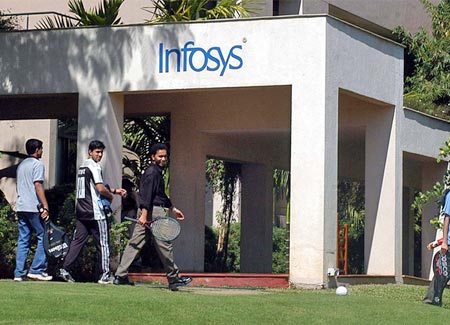|
| Help | |
| You are here: Rediff Home » India » Business » Pix |
|
 The growth of India's software industry through the 1990s made it the poster child for the success of the economic reforms process.
The growth of India's software industry through the 1990s made it the poster child for the success of the economic reforms process. In the second part of a series of excerpts from Nandan M Nilekani's book Imagining India, the Infosys [Get Quote] co-founder points out how IT firms set up new standards of entrepreneurship.
After the reforms in 1991, however, one thing changed dramatically -- India's software industry turned superstar. Our growth through the decade made us the poster child for the success of reforms. It was an entirely new experience for us, an industry that had so far been either reviled or ignored, and it marked the beginning of a huge change in how India viewed electronification.
India's IT firms -- Infosys, Wipro [Get Quote], Tata Consultancy Services [Get Quote] (TCS) -- propelled Indian industry and the economy into global view. We expanded faster than any other industry through the decade, growing from $150 million in 1991 to more than $5.7 billion in 2000. The rapid growth, the new technologies adopted and the expansion in both our competitors and value-chain partners made it an exhilarating time. In just a few years, we built the IT and operational infrastructure that had taken US companies decades to put in place, and by the late 1990s we were competing in operational excellence and scale not just with each other, but also with Western firms.
The early predictions for Indian IT were rosy -- the home-grown IT sector was expected to lead to technology and knowledge spillovers across the economy, and trigger a widespread trend in electronification and IT-led surges in productivity. But in the early 1990s, our growth, though dramatic, was also quite isolated. There were continued restrictions on capital and labour that limited the ability of India's industries to invest in technology. Diffusion rates of such technology as a result stayed abysmally low, with the vast majority of Indian companies spending less than 1 per cent of their turnover on IT.
Faced with a low-growth domestic market, our focus remained mostly on software exports. The way we grew reflected how little IT had penetrated outside our sector -- government policies that carved out software parks situated on the edges of cities meant that we built our IT offices alongside other IT companies. We were small, walled-off islands of cutting-edge infrastructure in urban environments with bad connectivity, potholed roads and chickens on the streets.
Instead, the early spillover of our industry was mostly in transforming the culture of India's business and entrepreneurship. By focusing on the export market, Indian IT firms absorbed global management practices and standards. Perhaps more importantly, it also enabled Indians to dream the dream of the working class in the United States and Europe throughout the twentieth century.
At Infosys we were taking in fresh-faced young graduates by the hundreds every month, people who within five years of employment could aspire to standards of living their parents had never experienced.
IT firms such as ours also had an enormous impact on attitudes towards entrepreneurship. We had grown up in an environment where Indian industry was monopolized by a dozen or so prominent business families -- family enterprises where first, second and third cousins would dominate middle and senior levels of management. In contrast, firms such as Infosys, were started by people without instantly recognisable surnames, and who did not have a business background.
My father had worked as a manager in a textile mill, and (Infosys founder N R) Narayana Murthy's had been a schoolteacher. Over the years, our unprecedented success motivated numerous new entrepreneurs -- at conferences and industry events, we met young, ambitious, educated people setting up their own firms, who claimed they were inspired by us, and among whom we could sense a new energy and a seemingly unshakeable confidence.
Imagining India: Ideas for the New Century by Nandan M Nilekani, Penguin Books India. Price Rs 699. | Buy the book at Rediff Shopping
Photograph: Rediff Archives
| Email | Print | Get latest news on your desktop |
|
|
| © 2009 Rediff.com India Limited. All Rights Reserved. Disclaimer | Feedback |